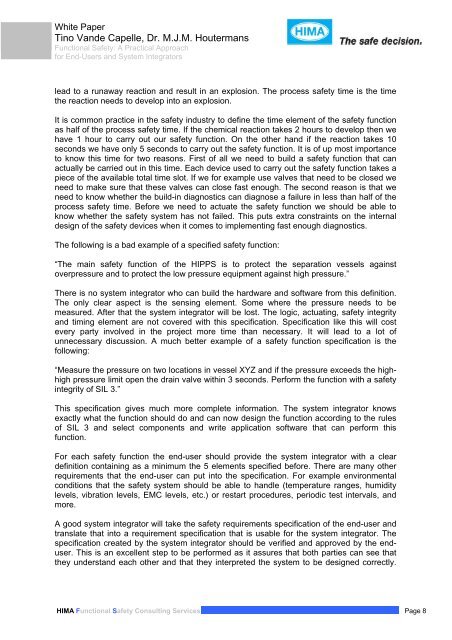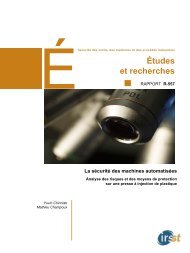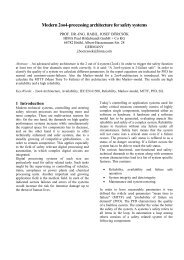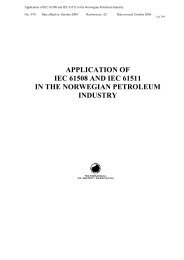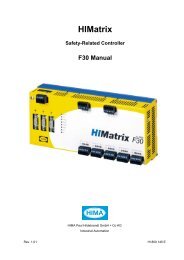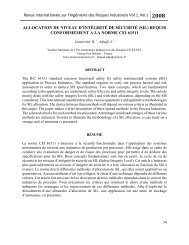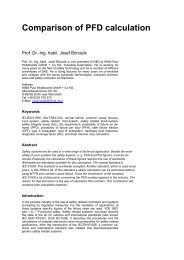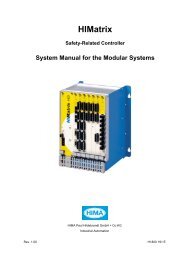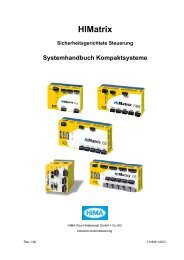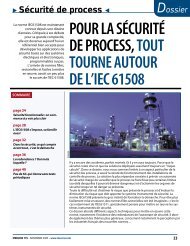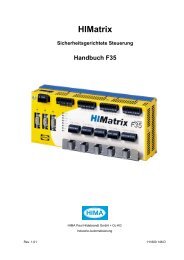Functional Safety
Functional Safety
Functional Safety
You also want an ePaper? Increase the reach of your titles
YUMPU automatically turns print PDFs into web optimized ePapers that Google loves.
White Paper<br />
Tino Vande Capelle, Dr. M.J.M. Houtermans<br />
<strong>Functional</strong> <strong>Safety</strong>: A Practical Approach<br />
for End-Users and System Integrators<br />
lead to a runaway reaction and result in an explosion. The process safety time is the time<br />
the reaction needs to develop into an explosion.<br />
It is common practice in the safety industry to define the time element of the safety function<br />
as half of the process safety time. If the chemical reaction takes 2 hours to develop then we<br />
have 1 hour to carry out our safety function. On the other hand if the reaction takes 10<br />
seconds we have only 5 seconds to carry out the safety function. It is of up most importance<br />
to know this time for two reasons. First of all we need to build a safety function that can<br />
actually be carried out in this time. Each device used to carry out the safety function takes a<br />
piece of the available total time slot. If we for example use valves that need to be closed we<br />
need to make sure that these valves can close fast enough. The second reason is that we<br />
need to know whether the build-in diagnostics can diagnose a failure in less than half of the<br />
process safety time. Before we need to actuate the safety function we should be able to<br />
know whether the safety system has not failed. This puts extra constraints on the internal<br />
design of the safety devices when it comes to implementing fast enough diagnostics.<br />
The following is a bad example of a specified safety function:<br />
“The main safety function of the HIPPS is to protect the separation vessels against<br />
overpressure and to protect the low pressure equipment against high pressure.”<br />
There is no system integrator who can build the hardware and software from this definition.<br />
The only clear aspect is the sensing element. Some where the pressure needs to be<br />
measured. After that the system integrator will be lost. The logic, actuating, safety integrity<br />
and timing element are not covered with this specification. Specification like this will cost<br />
every party involved in the project more time than necessary. It will lead to a lot of<br />
unnecessary discussion. A much better example of a safety function specification is the<br />
following:<br />
“Measure the pressure on two locations in vessel XYZ and if the pressure exceeds the highhigh<br />
pressure limit open the drain valve within 3 seconds. Perform the function with a safety<br />
integrity of SIL 3.”<br />
This specification gives much more complete information. The system integrator knows<br />
exactly what the function should do and can now design the function according to the rules<br />
of SIL 3 and select components and write application software that can perform this<br />
function.<br />
For each safety function the end-user should provide the system integrator with a clear<br />
definition containing as a minimum the 5 elements specified before. There are many other<br />
requirements that the end-user can put into the specification. For example environmental<br />
conditions that the safety system should be able to handle (temperature ranges, humidity<br />
levels, vibration levels, EMC levels, etc.) or restart procedures, periodic test intervals, and<br />
more.<br />
A good system integrator will take the safety requirements specification of the end-user and<br />
translate that into a requirement specification that is usable for the system integrator. The<br />
specification created by the system integrator should be verified and approved by the enduser.<br />
This is an excellent step to be performed as it assures that both parties can see that<br />
they understand each other and that they interpreted the system to be designed correctly.<br />
HIMA <strong>Functional</strong> <strong>Safety</strong> Consulting Services Page 8


